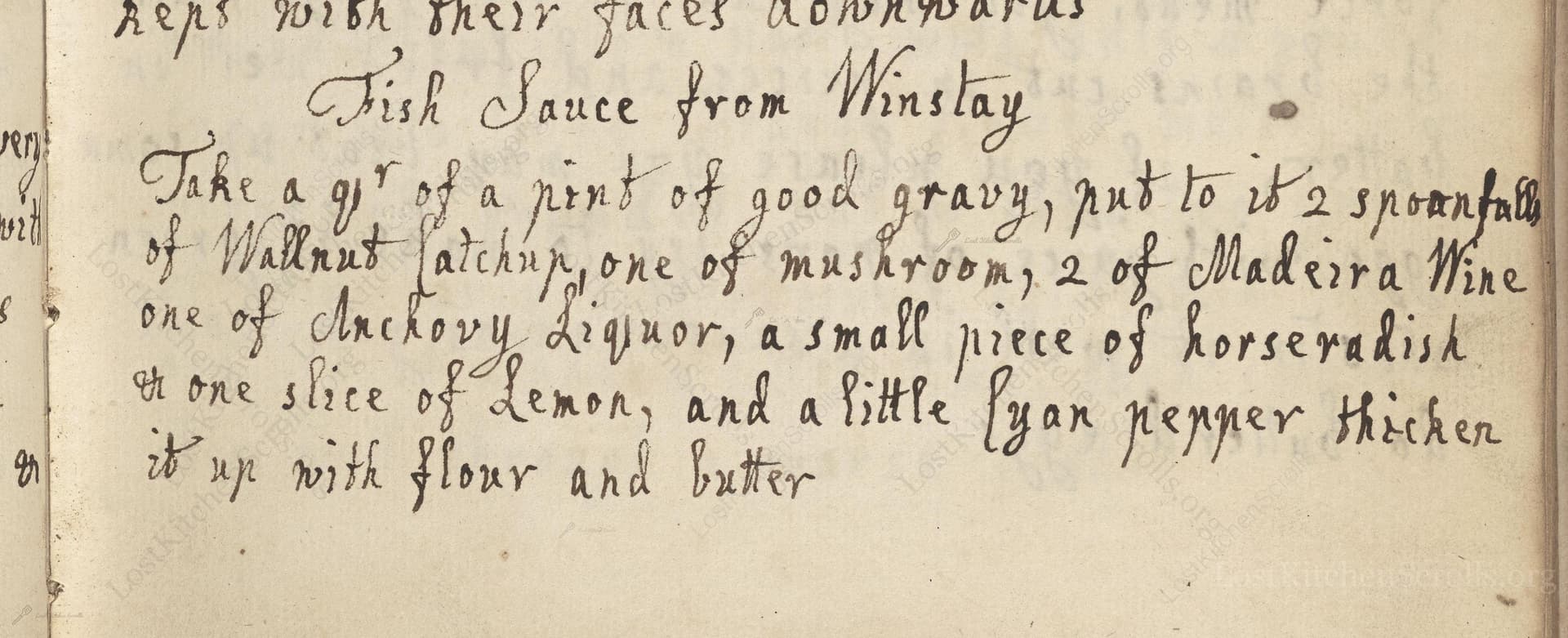Fish Sauce From Winstay
From the treasured pages of Cookbook of 1720
Unknown Author

Fish Sauce From Winstay
"Take a qr of a pint of good gravy, put to it 2 spoonfulls of Wallnut Catchup, one of mushroom, 2 of Madeira Wine one of Anchovy Liquor, a small piece of horseradish or one slice of Lemon, and a little Cyan pepper thicken it up with flour and butterr"
Note on the Original Text
The recipe is written in the crisp, telegraphic style typical of the early 18th century. Key quantities are abbreviated—'qr of a pint' means a quarter pint, or about 150 ml. 'Catchup' refers to the original mushroom or walnut-based savory condiments, not the sweet tomato variety familiar today. Spelling such as 'Cyan pepper' is a phonetic rendition of 'cayenne pepper.' Instructions are brief and assume the reader's familiarity with household cooking techniques, such as thickening sauces with flour and butter.

Title
Cookbook of 1720 (1720)
You can also click the book image above to peruse the original tome
Writer
Unknown
Era
1720
Publisher
Unknown
Background
Step back to the early 18th century and discover a delightful treasury of recipes and culinary secrets, where traditional flavors meet timeless technique—a feast for curious cooks and history lovers alike.
Kindly made available by
Folger Shakespeare Library
This Fish Sauce recipe hails from early eighteenth-century England, roughly around 1720. At the time, the British culinary scene was embracing bold flavors, many inspired by global trade. Ketchups—fermented, savory sauces often made from mushrooms or walnuts—were quite the rage, long before the tomato-based versions we know today. Anchovy essence and Madeira wine provided umami and depth, making sauces like this luxurious accompaniments for fish or roasted meat. Dishes like these showcased a household's refinement and access to imported goods.

Cooks in the early 1700s prepared sauces like this over an open hearth using sturdy saucepans made of copper or iron. Wooden spoons or metal ladles would stir and combine the ingredients. For thickening, a small bowl or plate might be used to combine butter and flour by hand. Sieving the finished sauce for smoothness might involve passing it through a cloth or fine mesh strainer, a standard practice for elegant presentation.
Prep Time
5 mins
Cook Time
8 mins
Servings
2
We've done our best to adapt this historical recipe for modern kitchens, but some details may still need refinement. We warmly welcome feedback from fellow cooks and culinary historians — your insights support the entire community!
Ingredients
- 5 fl oz good beef gravy
- 2 tbsp walnut ketchup
- 1 tbsp mushroom ketchup
- 2 tbsp Madeira wine
- 1 tbsp anchovy essence (or 1 anchovy mashed with 1 tbsp water as substitute)
- 3/4 inch piece fresh horseradish root (or 1 thin slice lemon as alternative)
- Pinch cayenne pepper
- 1/3 oz unsalted butter
- 1/10 oz (1 tsp) plain flour
Instructions
- To make this historical Fish Sauce, start by bringing 5 fl oz of good beef gravy to a gentle simmer in a small saucepan.
- Add 2 tablespoons of walnut ketchup, 1 tablespoon of mushroom ketchup, 2 tablespoons of Madeira wine, and 1 tablespoon of anchovy essence or liquor.
- Toss in a small piece (about 3/4 inch) of fresh horseradish root, or substitute with a thin slice of lemon if preferred.
- Season with a pinch of cayenne pepper to taste.
- To finish, thicken the sauce by stirring in a small knob (about 1/3 oz) of butter kneaded with 1 teaspoon (about 1/10 oz) of flour, stirring constantly until the sauce becomes smooth and slightly thickened.
- Strain before serving if a clear sauce is desired.
- This savory sauce pairs delightfully with fish or meats, an elegant nod to eighteenth-century table luxuries.
Estimated Calories
70 per serving
Cooking Estimates
You will only need a few minutes to prepare the ingredients, and then the cooking is just long enough to heat and thicken your sauce. This recipe makes enough for about 2 servings, and each serving has around 70 calories.
As noted above, we have made our best effort to translate and adapt this historical recipe for modern kitchens, taking into account ingredients nowadays, cooking techniques, measurements, and so on. However, historical recipes often contain assumptions that require interpretation.
We'd love for anyone to help improve these adaptations. Community contributions are highly welcome. If you have suggestions, corrections, or cooking tips based on your experience with this recipe, please share them below.
Join the Discussion
Rate This Recipe

Den Bockfisch In Einer Fleisch Suppen Zu Kochen
This recipe hails from a German manuscript cookbook compiled in 1696, a time whe...

Die Grieß Nudlen Zumachen
This recipe comes from a rather mysterious manuscript cookbook, penned anonymous...

Ein Boudain
This recipe comes from an anonymous German-language manuscript cookbook from 169...

Ein Gesaltzen Citroni
This recipe, dating from 1696, comes from an extensive anonymous German cookbook...
Browse our complete collection of time-honored recipes



